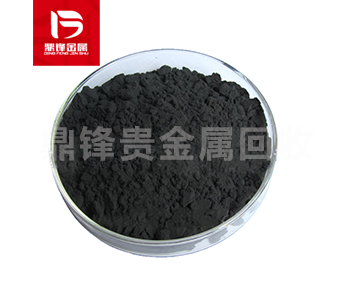
Palladium Graphite Recycling
Palladium graphite is a composite material composed of palladium (Pd) and graphite. Specific forms may include:
Palladium nanoparticles distributed in a graphite matrix
Palladium-graphite alloy or catalyst coating
Palladium graphite is a material composed of palladium (Pd) nanoparticles and graphene (or graphene oxide). Its typical structure includes palladium nanoparticles uniformly loaded on graphene sheets, or combined with magnetic materials (such as Fe₃O₄) to form a ternary composite material (such as Pd-Fe₃O₄/reduced graphene oxide nanocomposite). This structure combines the high catalytic activity of palladium with the high specific surface area, conductivity and stability of graphene, while the addition of magnetic components (such as Fe₃O₄) can realize the magnetic recovery properties of the material.
- Parameter
- Related Questions and Answers
-
Name : Palladium Graphite
-
Use : Catalytic reactions,Hydrogenation reactions
-
Application Areas : Electronic devices,Catalytic reactions
-
Appearance and properties : Black powder
-
Settlement Method : On-Site Payment
-
Recycling Type : Palladium recycling
-
Door-to-door recycling:worldwide
-
Customer service: Free content testing and door-to-door recycling
Product Details
Palladium graphite is a composite material composed of palladium (Pd) and graphite. Specific forms may include:
Palladium nanoparticles distributed in a graphite matrix
Palladium-graphite alloy or catalyst coating
Palladium graphite is a material composed of palladium (Pd) nanoparticles and graphene (or graphene oxide). Its typical structure includes palladium nanoparticles uniformly loaded on graphene sheets, or combined with magnetic materials (such as Fe₃O₄) to form a ternary composite material (such as Pd-Fe₃O₄/reduced graphene oxide nanocomposite). This structure combines the high catalytic activity of palladium with the high specific surface area, conductivity and stability of graphene, while the addition of magnetic components (such as Fe₃O₄) can realize the magnetic recovery properties of the material.
Application areas
Catalytic reactions
Palladium graphite has important applications in organic synthesis, such as:
Cross-coupling reactions: such as Suzuki-Miyaura coupling (coupling of arylboronic acid and halogenated aromatic hydrocarbons) and Mizoroki-Heck coupling (coupling of olefins and halogenated hydrocarbons), can be carried out in aqueous solution without the addition of toxic solvents, and are highly efficient and environmentally friendly.
Hydrogenation reactions: used in isomerization, hydrocracking and other reactions in petrochemicals, especially for highly selective and stable catalytic processes.
Environmental governance
Palladium-based catalysts can be used in automobile exhaust purification systems to reduce the emission of harmful gases (such as NOx and CO).
Deactivated palladium catalysts can be converted into water treatment catalysts, and phenolic pollutants can be selectively degraded by activating peroxymonosulfate (PMS), achieving "waste treatment with waste".
Electronic devices
Palladium graphite composites are used in electronic devices such as fuel cell electrodes and sensors due to their conductivity and stability.
Waste palladium graphite catalyst is one of the main sources of palladium containing noble metal catalyst. Recovery of palladium containing noble metal catalyst also includes Palladium(II) oxide recovery, Palladium(II) chloride recovery, palladium acetate recovery, Palladium(II) nitrate recovery, trimethyl Palladium(II) acetate recovery, Diphenylphosphine palladium recovery, etc. If you have any demand for palladium containing waste recycling, please call our 24-hour service hotline. Dingfeng Precious Metal Recycling and Refining Factory has independent recycling and refining factories without intermediaries to earn price differences. Our professional technical team and customer service personnel provide one-on-one services to ensure customer privacy during the recycling process.

